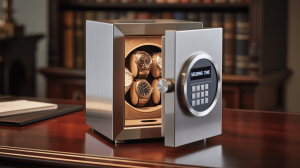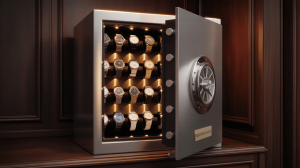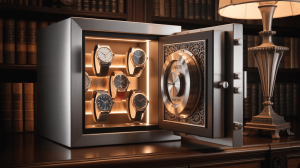The Ultimate Guide to Buying a Safe for Watches. But here’s the kicker… Your timepieces are more than mere accessories—they’re investments that deserve protection tailored to their value, environment, and your personal style. This guide walks you through every decision, from security certifications to interior organization, ensuring you choose a safe that keeps your collection both secure and showcase‑ready.
1. Identify Your Security Requirements
Assessing risk starts by understanding your environment. Are you in an urban area with higher break‑in rates or a quiet suburb? Insurance providers often require a UL RSC (Residential Security Container) or ETL burglary rating for coverage. Decide if you prefer mechanical dials—reliable without power—or electronic keypads that allow multiple user codes and audit logs. Biometric scanners add speed but may need periodic re‑enrollment. Finally, plan where you’ll anchor the safe: bolting to floor joists provides the highest theft deterrence, while wall or furniture anchoring offers stealth.
| Certification | Type | Benefit |
|---|---|---|
| UL RSC | Burglary resistance | Verified 5 min forced‑entry time |
| ETL Burglary | Equivalent standard | Independent lab validation |
2. Determine Fire and Heat Protection
Fires can reach temperatures over 1,000 °F within minutes. Look for UL 72 Class 350 ratings: 30 minutes at 1,200 °F or up to 120 minutes at 1,800 °F. Insulating materials—gypsum boards or ceramic composites—minimize heat transfer, keeping internal temps under 350 °F to protect delicate lubricants. Intumescent gaskets expand under heat to seal door seams against smoke and flames. Balance desired fire duration with safe size and weight, as higher ratings often increase bulk.
3. Measure Interior Capacity and Growth
Start by listing your current watches, straps, tools, and paperwork. Estimate pillow height (1.5–2 inches) plus clearance for winders or extra accessories. Plan for future acquisitions—leaving 20–30% additional space prevents overcrowding. Modular trays or inserts let you reconfigure the interior as your collection evolves. A snug, well‑measured fit enhances concealment and prevents items from shifting during opening.
4. Evaluate Exterior Materials and Build
The safe’s shell defines its resistance to attack. Exterior options include 12‑ to 14‑gauge steel for maximum rigidity, or aluminum alloys for lighter but still durable designs. Composite fireboards line interiors for heat protection. Corrosion‑resistant powder‑coat finishes prolong lifespan in humid climates, while wood veneers or leather wraps add luxury. Check weld quality at seams—continuous, tamper‑proof welds eliminate hidden weak spots.
| Material | Durability | Aesthetic |
|---|---|---|
| 12‑Gauge Steel | High forced‑entry resistance | Industrial or matte finishes |
| Composite Fireboard | Fire insulation | N/A |
| Wood Veneer/Leather | Decorative appeal | Premium look |
5. Choose the Ideal Lock Mechanism
Mechanical dials never rely on power but can be slower to operate. Electronic keypads support multiple user codes and time‑delay functions. Biometric scanners provide one‑touch access yet require registered fingerprints. Dual‑lock configurations combine two methods—such as keypad plus key—for layered security. Evaluate your priority between speed, reliability, and redundancy.
6. Assess Watch Winder Integration
For automatics, integrated winders save manual winding. Ensure modules allow customizable TPD (turns per day) and rotation directions (CW, CCW, bi‑directional). High‑quality motors run under 25 dB to avoid noise pollution. Programmed pause intervals prevent over‑winding. Removable winder trays convert to static storage when not in use, maximizing versatility.
7. Analyze Interior Organization
A well‑organized interior keeps watches pristine and easy to select. Use foam or velvet‑lined pillows matched to your case diameters. Adjustable watch trays let you rearrange slots quickly. Hidden compartments beneath trays store straps, spring bars, and cleaning tools out of sight. Customizable insert kits allow you to switch between winders, watch racks, or even small firearm cradles for dual‑purpose models.
| Organizer Type | Purpose | Advantage |
|---|---|---|
| Watch Pillows | Secure individual watches | Prevents scratches |
| Adjustable Trays | Custom layout | Accommodates varying sizes |
| Accessory Pockets | Store tools and straps | Keeps extras organized |
8. Verify Climate and Humidity Controls
Moisture can corrode metal parts and dry out leather straps. Look for sealed gaskets rated IP54 or higher to block dust and light water. Integrate desiccant chambers or silica gel packs to maintain relative humidity below 50%. Premium safes include digital hygrometers showing real‑time moisture levels, while active dehumidifier modules offer precise control in humid regions.
9. Test Ease of Access and Convenience
Routine use demands swift entry. Electronic keypads allow quick code entry; biometric scanners unlock in milliseconds. Time‑delay settings can deter brute‑force attempts. Always include backup manual keys or override dials to ensure access during power failures. Interior LED lighting activates upon opening, illuminating your watches without generating harmful heat.
10. Examine Noise and Vibration Levels
Watch winders and locking bolts can create noise. Look for vibration‑dampened mounts and motors rated under 25 dB—imperceptible in most rooms. Soft‑close hinges prevent slamming sounds. Review user feedback on actual noise levels in quiet environments like bedrooms or offices to avoid disruptive hums or clicks.
| Noise Control | Feature | Benefit |
|---|---|---|
| Vibration Dampening | Rubber motor mounts | Minimizes operational noise |
| Low‑Noise Motors | Precision engineering | Keeps dB under 25 |
| Soft‑Close Hinges | Hydraulic mechanism | Eliminates slamming |
11. Explore Smart Connectivity Features
Bluetooth or Wi‑Fi connectivity brings real‑time tamper, door‑open, and low‑battery alerts to your smartphone. Apps let you remotely lock/unlock, adjust TPD, set user codes, and view access logs. These features enhance convenience and security when you’re away from home.
12. Investigate Power and Backup Options
Dependable power ensures continuous operation of electronics and winders. Seek units supporting both AC adapters and rechargeable battery packs with low‑battery alerts. USB‑C or solar trickle chargers reduce waste. Always keep a hidden manual override key for emergencies—ensuring you never lose access.
| Power Source | Backup Method | Maintenance |
|---|---|---|
| AC Adapter | N/A | Regular plug‑in check |
| Rechargeable Pack | Manual key override | Recharge monthly |
| USB‑C | Hidden override PIN | Inspect cable quarterly |
13. Match Style with Décor
Your safe should integrate seamlessly. Matte black and satin white finishes suit contemporary interiors, while wood veneers or leather wraps complement luxury décor. Slim profiles slide into closets or cabinets unnoticed. Custom color matching and engraving options lend personalization for gifts or branded collections.
14. Balance Budget and Value
Safe prices range widely: entry‑level models ($100–$300) deliver basic burglary and static storage; mid‑range units ($300–$700) add fire ratings, electronic locks, and winders; premium safes ($700+) feature biometrics, smart apps, and luxury materials. Prioritize core certifications and interior needs before optional extras like décor or connectivity.
15. Confirm Warranty and Support
A robust warranty signals manufacturer confidence. Look for 2–5 year coverage on both safe structure and electronic components. Onsite service options, spare part availability, and responsive customer support streamline repairs and replacements. Read reviews on service experiences to avoid vendors with poor after‑sales care.
Conclusion
Choosing the perfect safe for watches means aligning security certifications, fire protection, capacity, materials, organization, climate control, access methods, smart features, style, budget, and support. Ready for the good part? Use this ultimate guide as your blueprint—compare certified models against your checklist to protect and showcase your collection in style.
FAQ
Q1: What fire rating is sufficient?
Aim for UL 72 Class 350—30 minutes at 1,200 °F or more for reliable heat protection.
Q2: Are biometric locks reliable long term?
Premium modules include encrypted templates and backup keys for redundancy.
Q3: How often replace desiccant packs?
Every 6–12 months depending on humidity levels.
Q4: Do smart features require subscriptions?
Basic app control is typically free; advanced monitoring services may incur fees.
Q5: Is professional installation necessary?
DIY anchoring to studs can suffice—follow manufacturer guidelines for best security.







